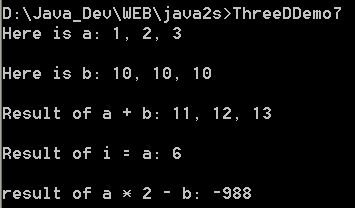Use an explicit conversion

/*
C#: The Complete Reference
by Herbert Schildt
Publisher: Osborne/McGraw-Hill (March 8, 2002)
ISBN: 0072134852
*/
// Use an explicit conversion.
using System;
// A three-dimensional coordinate class.
class ThreeD {
int x, y, z; // 3-D coordinates
public ThreeD() { x = y = z = 0; }
public ThreeD(int i, int j, int k) { x = i; y = j; z = k; }
// Overload binary +.
public static ThreeD operator +(ThreeD op1, ThreeD op2)
{
ThreeD result = new ThreeD();
result.x = op1.x + op2.x;
result.y = op1.y + op2.y;
result.z = op1.z + op2.z;
return result;
}
// This is now explicit.
public static explicit operator int(ThreeD op1)
{
return op1.x * op1.y * op1.z;
}
// Show X, Y, Z coordinates.
public void show()
{
Console.WriteLine(x + ", " + y + ", " + z);
}
}
public class ThreeDDemo7 {
public static void Main() {
ThreeD a = new ThreeD(1, 2, 3);
ThreeD b = new ThreeD(10, 10, 10);
ThreeD c = new ThreeD();
int i;
Console.Write("Here is a: ");
a.show();
Console.WriteLine();
Console.Write("Here is b: ");
b.show();
Console.WriteLine();
c = a + b; // add a and b together
Console.Write("Result of a + b: ");
c.show();
Console.WriteLine();
i = (int) a; // explicitly convert to int -- cast required
Console.WriteLine("Result of i = a: " + i);
Console.WriteLine();
i = (int)a * 2 - (int)b; // casts required
Console.WriteLine("result of a * 2 - b: " + i);
}
}
Related examples in the same category